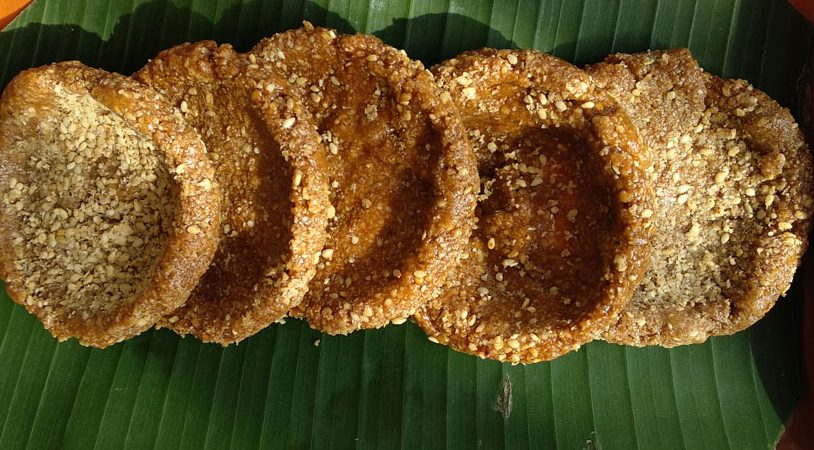Tilkut: A Sweet Symphony for Makar Sankranti!
Namaste Dosto! And a warm pranam to all my Bihari brothers and sisters! Chef Curry Do’pyaza here, ready to whisk you away on a delicious journey!
Today, we’re diving into a sweet treat that’s as essential to Makar Sankranti as kites are to the sky – Tilkut! This crunchy, nutty delight is more than just a sweet; it’s a symbol of warmth, prosperity, and the joy of new beginnings.
When Do We Devour This Deliciousness?
Tilkut is the undisputed king of Makar Sankranti, a vibrant festival celebrated across India, marking the end of the winter solstice and the beginning of longer, warmer days. It’s a time for kite flying, bonfires, and of course, sharing delicious treats like Tilkut with family and friends. In Bihar and Jharkhand, Tilkut is practically synonymous with the festival, found in every home and sweet shop. It is also a popular treat during Lohri and other winter festivals.
A Glimpse into the Past
The history of Tilkut is as rich and textured as the sweet itself. While precise origins are shrouded in the mists of time, it’s believed to have originated in the state of Bihar, India. For generations, families have passed down their secret Tilkut recipes, each with its own unique twist. It’s a testament to the ingenuity of our ancestors, who transformed simple ingredients into a delectable treat.
Let’s Get Cooking!
Here’s my family’s cherished Tilkut recipe. Don’t worry, it’s simpler than you think!
Preparation Time: 15 minutes
Cooking Time: 20 minutes
Ingredients:
- 250 grams Til (Sesame Seeds) – White or Black
- 200 grams Gur (Jaggery) – Preferably the darker variety for a richer flavor
- 1/4 teaspoon Elaichi Powder (Cardamom Powder) – For that aromatic touch
- 1 tablespoon Ghee (Clarified Butter) – Optional, for a richer taste and easier handling
Step-by-Step Instructions:
- Roast the Sesame Seeds: In a heavy-bottomed pan or kadai, dry roast the til (sesame seeds) over medium heat. Keep stirring constantly to prevent burning. They are ready when they turn light golden brown and start to pop. This usually takes about 5-7 minutes. Immediately transfer them to a plate to cool.
- Prepare the Jaggery: Grate the gur (jaggery) finely. This will help it melt evenly.
- Melt the Jaggery: In the same pan, melt the grated gur over low heat. Stir continuously to prevent it from sticking and burning. You can add a tablespoon of ghee (clarified butter) at this stage for a smoother texture. The jaggery is ready when it melts completely and starts to bubble slightly.
- Combine and Mix: Remove the pan from the heat. Quickly add the roasted sesame seeds and elaichi powder (cardamom powder) to the melted jaggery. Mix everything together thoroughly until the sesame seeds are evenly coated with the jaggery. Work quickly, as the mixture will start to harden as it cools.
- Shape the Tilkut: There are two ways to shape your Tilkut:
- Rolling: While the mixture is still warm, grease your hands with a little ghee (clarified butter). Take small portions of the mixture and roll them into small, round or oval shapes. Place them on a greased plate or parchment paper to cool completely.
- Flattening: Place the warm mixture between two sheets of parchment paper and roll it out thinly using a rolling pin. Cut into desired shapes (squares, diamonds, etc.) while still warm. Let them cool completely on the parchment paper.
- Cool and Enjoy: Allow the Tilkut to cool completely and harden. This usually takes about 30 minutes to an hour. Once cooled, store them in an airtight container.
Chef Curry’s Tips for the Perfect Tilkut:
- Roasting is Key: Don’t skip the roasting step! It brings out the nutty flavor of the sesame seeds and makes them more digestible.
- Low and Slow: Melt the jaggery over low heat to prevent burning. Burnt jaggery will give your Tilkut a bitter taste.
- Work Quickly: Once you add the sesame seeds to the melted jaggery, work fast to shape the Tilkut before the mixture hardens.
- Quality Ingredients: Use good quality sesame seeds and jaggery for the best flavor.
Tilkut Your Way: Adaptations and Variations
- Gas Stove: Follow the recipe as described above, using a heavy-bottomed pan on your gas stove.
- Induction Stove: Use a heavy-bottomed pan suitable for induction cooking and follow the recipe as described.
- Microwave (for melting jaggery): Place the grated jaggery in a microwave-safe bowl. Microwave in 30-second intervals, stirring in between, until melted. Be careful not to overheat it.
- Oven (for roasting sesame seeds): Spread the sesame seeds in a single layer on a baking sheet. Roast in a preheated oven at 350°F (175°C) for 5-7 minutes, or until lightly golden brown, stirring occasionally.
Nutritional Information (Approximate, per serving):
- Calories: 150-200
- Protein: 4-5 grams
- Fat: 8-10 grams
- Carbohydrates: 20-25 grams
Tilkut is a good source of iron, calcium, and healthy fats. However, it is also high in sugar, so consume it in moderation.
Serving Suggestions:
- Enjoy Tilkut as a standalone sweet treat.
- Serve it with a cup of hot chai or coffee.
- Offer it to guests during Makar Sankranti and other festivals.
- Pack it in your lunchbox for a quick and energy-boosting snack.
A Sweet Call to Action:
So there you have it, folks! My family’s treasured Tilkut recipe, ready for you to try at home. This Makar Sankranti, ditch the store-bought sweets and whip up a batch of homemade Tilkut. Share it with your loved ones, and spread the joy and warmth of the festival. I know you will enjoy this sweet treat!
Happy cooking, and Happy Makar Sankranti!
